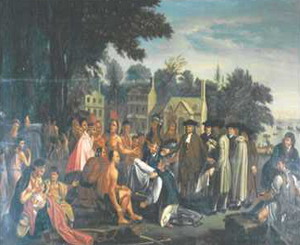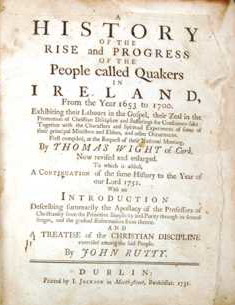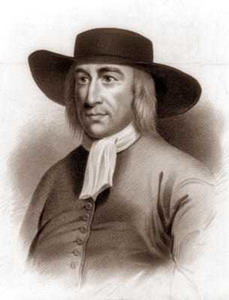The Quakers in Lurgan




In the year 1654 Lurgan was the site for the establishment of the first Quaker
meeting in Ireland initiated by the well know Quaker William Edmondson, the acknowledged pioneer of Irish Quakerism. He gathered a few like-minded individuals to worship in his house. Five miles to the west regular meetings were first held later in the same year in the home of Margery Atkinson near the ancient church of Kilmore. Soon after a permanent meeting was formed in the townland of Ballyhagan. To travel between the two places one would have to negotiate the river Bann at the crossing place of Port an Dunain (landing-place of the ferry).
Quakerism, which had its origins in England, became strong during the English
civil war period of the 1640's when such "radical" thought was fostered by the
army. By the 1650's Lurgan presented an ideal location for the Quakers. It was
unwalled, non-corporate, and guild free. Linen waving in North Armagh in similar fashion to peasant cloth techniques in England required transformation of technique by an injection of help and skill from outside the area. This the Quakers and others supplied.
History has shown us however that even in Lurgan the quakers were not free from
persecution. Christopher HILLARY had been a member of the Militia in Lurgan
under a Captain DRAPER. When he was convinced of "the truth" and accepted
friends ways he could no longer for conscience sake bear weapons and refused to
carry out his duties. As punishment he was put on a thing they call the wooden
horse with three muskets at each leg and ordered to sit till four inches of
match was burned and afterwards committed to gaol. At the following Assizes he
was cleared by proclamation, but kept in prison for fees.
 The Quakers were extremely good at keeping records. A record of the sufferings
of Friends in Ireland was kept and in the period until 1751 a total of 972
Friends were committed to prison and goods to a value of £98,403 were
distrained. When one transfers this amount into current values one realises the
extent of the distress which was suffered by a relatively small community.
The new settlers comprised a fairly wide cross-section of trade speople and
with the arrival of the Huguenots in Warringstown and Lisburn, a good base of
skills were present to create initiative. After establishing itself in the town of Lurgan - in the later half of the seventeeth century Quakerism had made a definite rural move to the surrounding
rural townlands. The Quakers were extremely good at keeping records. A record of the sufferings
of Friends in Ireland was kept and in the period until 1751 a total of 972
Friends were committed to prison and goods to a value of £98,403 were
distrained. When one transfers this amount into current values one realises the
extent of the distress which was suffered by a relatively small community.
The new settlers comprised a fairly wide cross-section of trade speople and
with the arrival of the Huguenots in Warringstown and Lisburn, a good base of
skills were present to create initiative. After establishing itself in the town of Lurgan - in the later half of the seventeeth century Quakerism had made a definite rural move to the surrounding
rural townlands.
By 1664 William EDMONSON and his brother John had moved to a farm in County
Cavan, having given up their Lurgan shop. William LYNASS, Mark WRIGHT and Mark
SAWYER had also moved to rural Lurgan areas. By the late seventeenth century the rising commercial power of the quakers was reflected in the business affinity between Lurgan's leading Quaker Robert HOOPE,
and Arthur BROWNLOW (the lord of the manor), in their joint venture when
purchasing the Richmond estate, which was more or less co-extensive with the
parish of Tartaraghan, West of the Upper Bann. This purchase was an early
indication that the local Quaker community might not put down deep roots in an
urban setting and would, for the most part, depart from Lurgan and settle in
rural parts nearby.
To the east of Portadown a vigorous group of Friends was already in being. However they looked to Lurgan as their centre and focus as most were tenants of the Brownlow estate. The majority were immigrants from the North of England and they brought with them skills that were valued by the ambitious and enterprising landlord, Arthur Chamberlain Brownlow. He readily accepted as tenants weavers and tanners who were likely to develop the economic potential of his lands. Many lived in the area between Portadown and Lurgan in the parish of Seagoe. Early meeting places included the homes of Francis Robson in Tamnificarbet and of Roger Webb in Aughacommon, only a few miles from the Portadown crossing-place. The old Friends burial-ground at Lynastown was also in this densely settled area.
 By 1693 at least fourteen Quaker families were dwelling in Lurgan town. This
urban concentration was probably related to the growth of the town's linen
industry. The mutual well being of all Quakers could best be advanced by having
some in the country and others in town. Marketing and some degree of bleaching
and finishing were down in town, whilst flax-growing, spinning and weaving were
all country based. By this stage the Quaker community was no longer subject to persecution and in
fact was favoured by the Brownlows because of their contribution to the
propsperity of the town throught their industry and enteprise. Their particular
ways were tolerated and they no longer posed a threat to the eccliastical
establishment. By the end of the century most of the original pioneers of the
movement had died and the fire which characterised their radical message had
waned. By 1693 at least fourteen Quaker families were dwelling in Lurgan town. This
urban concentration was probably related to the growth of the town's linen
industry. The mutual well being of all Quakers could best be advanced by having
some in the country and others in town. Marketing and some degree of bleaching
and finishing were down in town, whilst flax-growing, spinning and weaving were
all country based. By this stage the Quaker community was no longer subject to persecution and in
fact was favoured by the Brownlows because of their contribution to the
propsperity of the town throught their industry and enteprise. Their particular
ways were tolerated and they no longer posed a threat to the eccliastical
establishment. By the end of the century most of the original pioneers of the
movement had died and the fire which characterised their radical message had
waned.
To the west near Loughgall and Richhill on the Cope and Richardson estates there was a quite different settlement. The area is still known as "the orchard country" and many of the farmers who took up leases brought a knowledge of fruit cultivation to their adopted land. Among these settlers too were many who responded readily to the Quaker message of William Edmondson and other pioneers and formed a strong community in this district.
By 1692 a further group of Friends were meeting about three miles to the south of Portadown and some years later they built a meeting house at Moyallon which still stands. Like many of the Lurgan Friends they were involved in the production of linen. They saw the potential of water power on the Bann and along the valley of this river many bleach greens and other enterprises associated with the linen trade were set up.
Although a number of the Friends, especially those in the linen trade, were very
wealthy, it is clear that many were in poor circumstances. Failure of harvest
at recurring intervals produced real suffering and waves of emigration to North
America were evident about 1729, 1750 and 1770.
From the middle of the eighteenth century reports on the state of the meeting
indicate that the Lurgan Friends were concerned about their poor spiritual
health and vigour. Families which had prospered in the linen trade moved in
circles which had a lifestyle very different from that which was recommended by
friends. Adherence to the quaint form of address and plain clothes, persistance
in refusing legal oaths and avoiding the payment of tithes and other Quakerly
peculiarities were of little value in furthering their commercial interests and
thus were gradually abandoned.
 The general spirit of the age which is often designated as the Enlightenment produced many factors which affected traditional Christian faith. By the late eighteenth century some friends were voicing difficulties over the authority of the Bible, particularly with reference to parts of the Old Testament, and were exalting the role of direct revelation. These Friends, who were popularly called "New Lights", were also critical of traditional forms of Quaker testimonies which did not radically address the demands of contemporary life. Confrontation between the "New Lights" and orthodox friends, which had simmered
for some time and was associated with support for or opposition to visiting American ministers came to a head over an irregular wedding ceremony in 1801. Elizabeth DOYLE wished to marry a local friend John ROGERS and applied to marry without going through a round of formal ceremonies. This permission was refused, so the couple took each other in marriage at a specical meeting held in the Friends School in Lisburn, attended by a number of prominent friends. The newly weds were promptly disowned and also all of those friends who had sanctioned their union by their attendance at the ceremony. The general spirit of the age which is often designated as the Enlightenment produced many factors which affected traditional Christian faith. By the late eighteenth century some friends were voicing difficulties over the authority of the Bible, particularly with reference to parts of the Old Testament, and were exalting the role of direct revelation. These Friends, who were popularly called "New Lights", were also critical of traditional forms of Quaker testimonies which did not radically address the demands of contemporary life. Confrontation between the "New Lights" and orthodox friends, which had simmered
for some time and was associated with support for or opposition to visiting American ministers came to a head over an irregular wedding ceremony in 1801. Elizabeth DOYLE wished to marry a local friend John ROGERS and applied to marry without going through a round of formal ceremonies. This permission was refused, so the couple took each other in marriage at a specical meeting held in the Friends School in Lisburn, attended by a number of prominent friends. The newly weds were promptly disowned and also all of those friends who had sanctioned their union by their attendance at the ceremony.
The state of Quakerism in Lurgan in 1822 was well discribed by John CONRAN who
was the sole remaining minister. His disappointment is evident when he thinks
of the situation many years before:
"The monthly meeting held in Lurgan (was) a very small gathering and a poor low
time. ....under painful exercise I felt on account of the meeting (about eight
or nine men), I told them I remembered when there were 63 families who were
esteemed in membership and about 60 families not in membership when I visited
them"
Some Lurgan Quaker Names
BARROW from Lancashire
BRADSHAW from Lancashire - In 1670 the BRADSHAWS, of farming background leased
almost half of Dumnakelly townland. In 1711, James BRADSHAW, decribed as a
linen draper renewed the lease. In 1728, after two visits to Holland to study
techniques used by Dutch linen manufacturers, BRADSHAW presented an improved
version of the sleying table for looms to the Linen Board. BRADSHAW became
quite wealthy using his aquired skills, so much so that by 1750 he was able to
secure a freehold lease by paying BROWNLOW 70 guineas and a fine piece of linen.
CAIN from Yorkshire
CALVERT from Yorkshire - an early dweller in the townland of Drumgor.
in 1673 John was one of the trustees of the Quaker burial ground. He was listed
as a freeholder from Lurgan.
CHAMBERS from Yorkshire
FOX from Cumberland
GREER from Northumberland - Thomas of Dungannon was a notable merchant and
active friend and his life and interests are well document in the GREER papers
at the PRONI
HARLAND
The HARLAND family originally from Yorkshire were a strong Lurgan Quaker family.
George and Michael HARLAND arrived in America in 1687. George brought his wife
and young family and Michael who was unmarried found a wife in the new
settlement shortly after his arrival. She was Dinah DIXON, originally from
Lurgan. The HARLANS as they spelt their name after arrival in America became a
widely connected and eminent family in the USA. One of their descendants
married a son of Abraham LINCOLN and another was the wife of President McKinley.
HILLERY from Yorkshire
HODGSON from Cumberland
HOLLINGSWORTH - in 1673 Valentine was one of the trustees of the Quaker burial
ground. He was listed as a freeholder from Ballymacrandle. The HOLLINGSWORTHs
settled in the district in the early 17th century. Valentine was born in 1632
in Ballymacrandle in the parish of Seagoe. Valentine left Ireland in 1682 for
Delaware in the States. There is a well know HOLLINGSWORTH website which covers
the early history of this family.
HOOPE
From humble beginnings, during the period 1664-1700 Robert HOOPE progressed to
become one of the town's wealthiest citizens.
KIRK from Yorkshire
LINAS from Yorkshire - Will LYNAS witnessed the appointment of the trustees for
the burial ground in 1673. Will was an elder dieing in 1658.
LOGAN
Patrick and Isabel LOGAN Settled in Lurgan in 1671 from Scotland. Patrick had
nine children of whom only two survived childhood, James and William. James
LOGAN left Lurgan in 1699 to become William PENN's secretary in Pennsylvania.
MATTHEWS - in 1673 William and Alexander were trustees of the Quaker burial
ground. William listed as a Merchant Taylor from Lurgan, Alexander was listed
as a Blacksmith
PORTER from Yorkshire
ROBSON from Yorkshire
STAMPER from Cumberland
TURNER from Northumberland
WALKER from Cumberland
WEBB - Roger was the son of an earlier settler and was born in Dunmurry in 1622. He moved to Lurgan in the middle of the century and acquired a lease of the
townland of Annaloiste and part of Aghacommon.
Other names include: UPRICHARD, RICHARDSON, CHRISTY, DAWSON and HALLIDAY


| 
